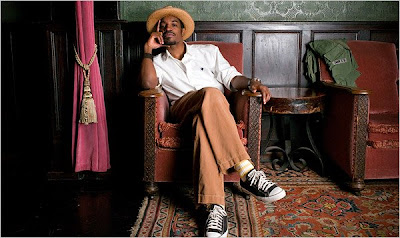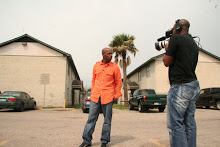
By ERIC WILSON
Published: October 1, 2008
HAS there ever been a celebrity who, in the cause of promoting a fashion label, did not want to be known as more of a designer than a celebrity? It is kind of nice to imagine all the man-hours Jennifer Lopez, Sean Combs and Beyoncé have spent laboring at a sewing machine lest anyone doubt the sincerity that went into affixing their logos on $90 jeans.
Skip to next paragraph
Enlarge This Image
COOL, CALM, COLLEGIATE Plus fours and club sweaters are among the attire from the Benjamin Bixby clothing line.
But at a party at Barneys New York during Fashion Week, André Benjamin, his hands thrust into the pockets of his suspender pants, really did look as if he would rather curl up at home with his Singer than be known as another singer who can sew. He was there to introduce a line of men’s wear called Benjamin Bixby, which includes tweed plus fours and club sweaters with leather elbow patches. The collection was inspired by Ivy League athletics of the 1930s. It looked like Ralph Lauren having a Steampunk moment.
By designing under an assumed name, Mr. Benjamin is reflecting the latest trend in celebrity fashion, which is for celebrity designers to masquerade as nobody designers, and thereby appear to be more authentic than opportunistic. (William Rast and Edie Rose are not Parsons alumni, but the labels of Justin Timberlake and Rachel Bilson.)
Most of those collections, minus the labels, would look exactly the same: artsy dyed jeans, trendy T-shirts, fur-trimmed bomber jackets, etc. But plus fours? Mr. Benjamin has the field to himself. His collection is so unexpectedly nostalgic as to seem designed for another era. Or another world.
“I think people will judge what I do a little harder than someone who was just starting out,” said Mr. Benjamin, who has a point.
As André 3000 of OutKast, he suavely crafted an alter ego with a distinctive retro-preppy-nerdy style and used fashion magazines, which were captivated by his look, to promote his image. He often showed up at photo shoots with bags of his own dandy clothes and was photographed in them, as when he appeared in a long houndstooth overcoat with Kate Moss in Rolling Stone. In 2005, he made the International Best-Dressed List in Vanity Fair.
But it was, to an extent, an act. Mr. Benjamin, 33, describes his true personality as more reserved and says that the flair was largely effect, to create a character. Then, as his career grew from singing to acting and now fashion, he became more skilled at manipulating the image.
For his latest movie role, Mr. Benjamin, portraying a protester at the 1999 demonstrations against the World Trade Organization in “Battle in Seattle,” dressed as a turtle.
“What I love are the possibilities,” he said. “It’s the same thing in music and the same thing in acting and the same thing in fashion. If I want to play this person, I can become this person.”
The name Benjamin Bixby derives from an episode of MTV’s “Punk’d” on which Mr. Benjamin was the victim of an elaborate joke: At the fabricated scene of a car accident, a Maybach salesman demanded his name, implying that Mr. Benjamin was responsible for the damages. Unaware of the setup, he blurted out “Bixby,” the last name of the actor who starred in the television series “The Incredible Hulk.”
Later, to create a persona for his fashion line, Mr. Benjamin combined his surname with that of Bill Bixby. The character is a world traveler whose wardrobe includes things like a $995 cotton corduroy blazer, a $350 felted waistcoat and a $95 newsboy cap. At Barneys, those clothes now hang next to lines like Double RL and Engineered Garments, which have a similar bent of Depression Chic.
The reaction from young men has been strong, said Tom Kalenderian, the men’s wear fashion director at Barneys. “Though you are looking at plus fours and collegiate sweaters that remind you of the past, it is very current with today.”
Mr. Benjamin’s point of view was shaped as a teenager in Atlanta, where, to stand out, he often customized his clothes and dyed his jeans turquoise or orange. He was into fashion back then, he said, noting that his favorite brands were “Alexander Julian Colours, Ralph Lauren, Generra, early Guess, Bugle Boy, Tretorn, Lacoste, Levi’s, Britches, Helly Hansen, Eddie Bauer, L. L. Bean, Bass, early Timberland and early Banana Republic, when they were still doing adventure wear.”
“For an African-American guy to be a prep, that’s a dichotomy,” he said. “Prep style comes from mostly affluent families who just wear these cool clothes. But when you come from a background that has more struggle, your take on it will be different. There’s a certain kind of rebel to it.”
When Mr. Benjamin first showed his men’s wear in February, it was surely a surprise to anyone who envisioned an urban street-wear brand, but perhaps not so for an artist who had demonstrated a fondness for straw boaters and bow ties. He said the style was just classic.
“I can’t pretend I’m from New England or I’m at school at Harvard or Oxford, but when you think of men’s dress, you have to give a nod to England,” he said. “They created it all and brought it to America. We calmed it and made it cool.”















No comments:
Post a Comment